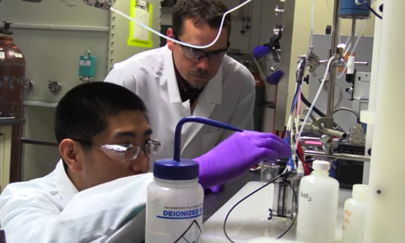In a strange twist of experimental events, chemists at the Oak Ridge National Laboratory, in Tennessee, accidentally converted carbon dioxide into ethanol fuel. The process they stumbled upon is electrochemical as they used small shafts of copper and carbon to convert the CO2 into the ethanol fuel.
Adam Rondinone, lead author on the experiment, said that, “We discovered, somewhat by accident, that this material worked. We were trying to study the first step of a proposed reaction when we realized that the catalyst was doing the entire reaction on its own.”
The research team sent electrical voltage into a catalyst of copper, nitrogen and carbon. The reaction they observed was unexpected. What they ended up doing was reversing the process of combustion. When this CO2 solution was placed in a container of water, it turned into ethanol. This was not a normal turn of events as such an electrochemical reaction generally ends up with several different products none of which are ethanol.
Rondione went on to state that, “We’re taking carbon dioxide, a waste product of combustion, and we’re pushing that combustion reaction backwards with very high selectivity to a useful fuel. Ethanol was a surprise. It’s extremely difficult to go straight from carbon dioxide to ethanol with a single catalyst.”
The catalyst consists of carbon spikes that are infused with nanoparticles of copper. Because of this combination, the chemists were able to make the process economically viable because, normally, they would have had to use a rare, and expensive, metal like platinum to achieve the results they were looking for. Because of the multiple spikes, the reaction, it seems, has many more places to happen which helped contribute to the ethanol producing reaction.
“By using common materials but arranging them with nanotechnology,” Rondione said, “we figured out how to limit the side reactions and end up with the one thing we want.”
PHOTO CREDIT: Oak Ridge National Laboratory

